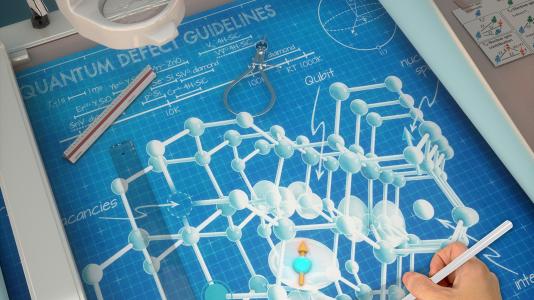Argonne-led research team highlighted in special issue on quantum systems

In an article featured on the cover of this month’s Nature Reviews Materials, researchers at the U.S. Department of Energy’s Argonne National Laboratory, the University of Chicago, and institutions in Japan, Korea and Hungary provide a blueprint for a class of materials that is quickly emerging as an important player in quantum science: crystals with defects.
The defects — irregularities deliberately embedded in the crystal’s structure — act like a trap for quantum particles. In their most fundamental form, these systems are known as qubits, the basic unit of quantum information.
“That Nature Reviews has focused an entire issue on the topic of qubit materials recognizes the prominence of this area of research. We’re moving quantum science into the realm of usable, scalable devices, and developing quantum materials is foundational to that effort.” — David Awschalom
The research team’s article in Nature Reviews Materials is one among several in an issue devoted entirely to the development of quantum systems.
“That Nature Reviews has focused an entire issue on the topic of qubit materials recognizes the prominence of this area of research,” said the article’s lead author David Awschalom, Argonne senior scientist, the University of Chicago Liew Family professor in molecular engineering and physics, and director of the Chicago Quantum Exchange. “We’re moving quantum science into the realm of usable, scalable devices. Developing quantum materials is foundational to that effort.”
A mashup of “quantum” and “bit,” the qubit corresponds to the traditional computing bit. Its physical realization can take on a variety of forms: It might be a lab-made molecule. Or it could be an electron traveling in a specialized superconducting circuit.
It could also be a particle of light trapped in a defect deep inside a fleck of diamond. This defect-in-a-crystal family of materials is the focus of the Awschalom team’s study, and they go by a fancy name: solid-state spin qubits. (The term spin refers to a quantum property of an electron that scientists manipulate to process information. Solid-state materials comprise insulators or semiconductors, such as diamond or silicon.)
“One advantage of a semiconductor qubit is that you can potentially leverage many of the solid-state technologies that are readily available from the semiconductor industry: integrated devices and circuits and the nanofabrication and processing that comes with solid-state systems,” Awschalom said.
Researchers engineer qubits based on how they will be used, whether in computing, communication or sensing, opening powerful new ways of processing information. Quantum sensors are expected to operate with many times the resolution of today’s sensors, enabling the study of human cells at the molecular level. Quantum communication networks promise to enable the transmission of hackerproof messages. And quantum computers will be able to rapidly game out complex simulations such as those used in the pharmaceutical industry, enabling faster drug delivery, for instance.
The development of practical qubits is key to a quantum future. In the Awschalom team’s handbook on solid-state spin qubit materials, researchers lay out their properties, engineering considerations and potential applications.
“We aimed to be materials-agnostic. We aren’t making direct suggestions about what materials one should use in developing quantum devices,” said co-author F. Joseph Heremans, a scientist at Argonne and University of Chicago. “Instead, we’re saying that, if you’re thinking about designing these devices from the ground up, these are the properties and behaviors you’ll want to consider.”
Both the host material and the defect are taken into consideration.
“It highlights the intricate interplay between the defect and the host material and the complex properties that need to be balanced for specific applications,” Heremans said.
For instance, many quantum communication devices are designed to be compatible with today’s telecom fiber optics, which send and receive infrared signals. Qubit materials that transmit light in the infrared spectrum, rather than the visible-light range, are better suited to such devices.
Quantum sensing devices, on the other hand, are often designed to pick up signals from a nearby source. Since quantum sensors aren’t subject to the same strict, long-distance, fiber-optical constraints, they tend to work well with materials that transmit light that is easily detectable in the visible-light spectrum.
The research team’s blueprint is the result of 10-plus years of research on solid-state spin defects.
“This can be a resource for people coming into the field or are curious about it — graduate students, postdocs, people writing research proposals,” said co-author Giulia Galli, a scientist at Argonne and professor at the University of Chicago. “Having this set of guidelines means they won’t have to reinvent the wheel. They can use this guide to consider how we think about qubits and all the intricate properties they have.”
And who knows — the team’s blueprint may become one chapter in a future qubit compendium that encompasses the full breadth of quantum materials.
“We’re at the threshold where the field of quantum information is moving from science to engineering. Practical quantum technologies are on the horizon, and materials development is one of the biggest challenges on our way to realizing them,” Awschalom said. “As a collection, the Nature Reviews articles present interesting avenues for research and motivate people to think broadly about this fast-growing area of quantum materials.”
This work was supported by the U.S. Department of Energy, Office of Science, Basic Energy Sciences, Materials Sciences and Engineering Division.
Argonne National Laboratory seeks solutions to pressing national problems in science and technology by conducting leading-edge basic and applied research in virtually every scientific discipline. Argonne is managed by UChicago Argonne, LLC for the U.S. Department of Energy’s Office of Science.
The U.S. Department of Energy’s Office of Science is the single largest supporter of basic research in the physical sciences in the United States and is working to address some of the most pressing challenges of our time. For more information, visit https://energy.gov/science.